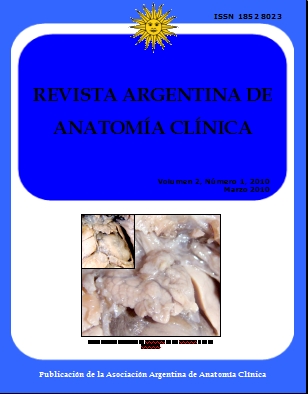ANATOMÍA QUIRÚRGICA DEL COLGAJO OSTEOCUTÁNEO DE PERONÉ Y SU APLICACIÓN EN RECONSTRUCCIÓN MANDIBULAR SURGICAL ANATOMY OF THE FIBULAR OSTEOCUTANEOUS FREE FLAP IN MANDIBULAR RECONSTRUCTION
DOI:
https://doi.org/10.31051/1852.8023.v2.n1.13862Palabras clave:
cirugía reparadora, resección mandibular, colgajos microquirúrgicos, reconstructive surgery, mandibular resection, free flap.Resumen
Introducción: La reconstrucción mandibular constituye un permanente desafío ya que implica la restauración de múltiples funciones. Se han ensayado diversas técnicas y materiales siendo en la actualidad el colgajo de peroné el estándar de tratamiento reconstructivo. Objetivos: Estudiar las características del colgajo peroné aplicado a la reconstrucción mandibular. Material y método: Entre enero de 2006 y abril de 2009 se realizaron un total de 18 colgajos microquirúrgicos de peroné, siendo el 50% de tipo osteocutáneos. Diez fueron mujeres con una edad promedio de 58 años. Resultados. Encontramos constante la disposición anatómica vascular, tanto la irrigación ósea como de la pastilla cutánea, así también como la anatomía nerviosa y los parámetros musculares para el abordaje del hueso. Hallamos un promedio de 1,7 ramas perforantes septocutáneas. No obtuvimos pedículos vasculares mayores a 8 cm. de longitud. El resultado estético y funcional de nuestras reconstrucciones fue más que aceptable aportando buena cantidad de tejido óseo e incluso en 3 casos fueron colocados implantes osteointegrados. Conclusiones: El colgajo microvascularizado de peroné, en sus diferentes variedades osteo u osteocutáneo, constituye un colgajo seguro, siendo la primera elección en reconstrucción mandibular, debido a sus características anatómicas óseas, a su constante disposición anatómica vascular, y al mínimo déficit que produce en la zona dadora.
Introduction: The mandibular reconstruction is a permanent challenge as the restoration of many functions depends on it. Multiple techniques and materials have been used and, at the present, the fibular free flap is the goal standard reconstructive treatment. Objective: We studied the characteristics of the fibular flap applied to the mandibular reconstruction. Material and method: We performed a total of 18 microsurgical fibula free flap between January 2006 and April 2009; 50% of them were osteocutaneos type. Ten were women and average age was 58 years. Result: Anatomic elements had regular distribution, including the vascular supply, as well the for the bone as for the skin paddle, nervous branches and muscular parameters considered for bone approach. Perforating septo-cutaneous branches were 1.7 average. We could not manage vascular pedicles longer than 8 cm. Stetic and funtional results could be considered better than acceptable, providing good cuantity of bone tissue and including three cases of osseointegrated implants. Conclusions: The fibular free flap is safe, being the first choice in mandibular reconstruction, due to the anatomical bone characteristics, the constant vascular anatomy and the minimal mobility caused to the donor.
Descargas
Publicado
Número
Sección
Licencia
Los autores/as conservarán sus derechos de autor y garantizarán a la revista el derecho de primera publicación de su obra, el cuál estará simultáneamente sujeto a la Licencia de reconocimiento de Creative Commons que permite a terceros compartir la obra siempre que se indique su autor y su primera publicación en esta revista. Su utilización estará restringida a fines no comerciales.
Una vez aceptado el manuscrito para publicación, los autores deberán firmar la cesión de los derechos de impresión a la Asociación Argentina de Anatomía Clínica, a fin de poder editar, publicar y dar la mayor difusión al texto de la contribución.



